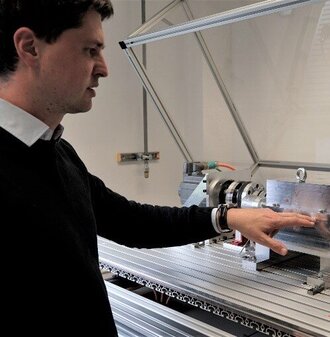
In the Drive Technology Laboratory at Furtwangen University, it's all about the right revolution for electric cars
If you want to improve the vehicle transmission of electric vehicles, you have to go back to basics – of that Prof. Dr. Steffen Jäger is convinced. Jäger teaches in the Faculty of Business Administration and Engineering at Furtwangen University and orchestrates in his laboratory what makes an electric vehicle move. The parts of the drive system that he focuses on most are gear wheels.
"Orchestrated" is fitting in this context, because Jäger's lab is (also) about sound. " How a machine or the drive of an electric car should sound is a very interesting question," says Jäger, who has a background in vehicle product development and brings this experience with him to HFU. With combustion engines it's clear – the quieter, the more sophisticated – and the more expensive. However, internal combustion engines also work at completely different speeds than electric motors. With the latter, 20,000 revolutions and more are quite normal. "In an electric vehicle it’s the gear meshing you hear as opposed to a loud combustion engine, " says Jäger. So, it's all about making gears quiet and optimising their efficiency. In the "LeeAS” (Quiet and Efficient Electric Drive Systems) research project, Prof. Jäger is collaborating with the Furtwangen-based company KOEPFER, which specialises in gear and transmission components. This is also where the gears with particularly “slanted teeth” come from, which Jäger has already installed in a gearbox model. He is currently working on optimising noise and efficiency by modifying profiles in the micro range.
Precise sound analysis and virtual simulation
Of course, Prof. Jäger is not simply recording the decibel figures measured during test runs in the laboratory. Jäger is also coordinating the construction of an entire test rig to carry out virtual coupling. "The test stand simulates gears installed in an electric car driving through the Black Forest," says Jäger. Through the simulation on the test bench and the simulations of the systems running simultaneously on computers, Jäger tests how the transmission can be improved, for example in terms of lower weight and optimised acoustic emission. To do this, he also takes a close look at the housing, or rather, under the microphone.
In the balancing act of volume, revs, efficiency and driving comfort, it is also important to bear in mind that electric vehicles no longer actually shift gears. "We see great potential in manual transmissions, especially for commercial vehicles," says Jäger, "because the efficiency characteristics of an electric motor can be utilised much better if you shift gears.” If gearshifts are used, the whole motor can be significantly reduced, "eventually to the size of a shoebox".
In his passion for the field of airborne sound, Prof. Jäger benefits from his fine ear as a musician. Numerous exhibits in his laboratory testify to his eagerness to experiment. Jäger shows an "impulse hammer" that is struck on a pipe. "We put energy into a system and then observe what the system does with it," he explains. Vibrations are also tested on a small wind turbine. "Every machine has a natural frequency," enthuses Jäger. Good vibes prevail in his lab not just in research methods, but also in collaboration – the real and virtual possibilities are also used by students as well as scientists in other departments and universities.
The LeeAS project is scheduled to run for four and a half years and is funded by the Federal Ministry of Education and Research as part of the FH-Kooperativ programme.